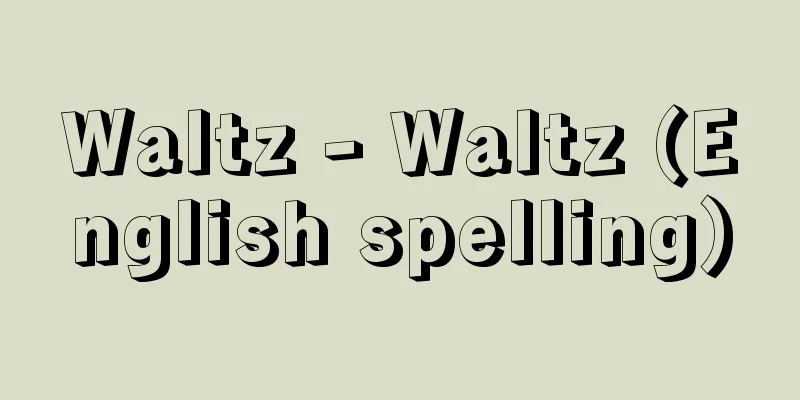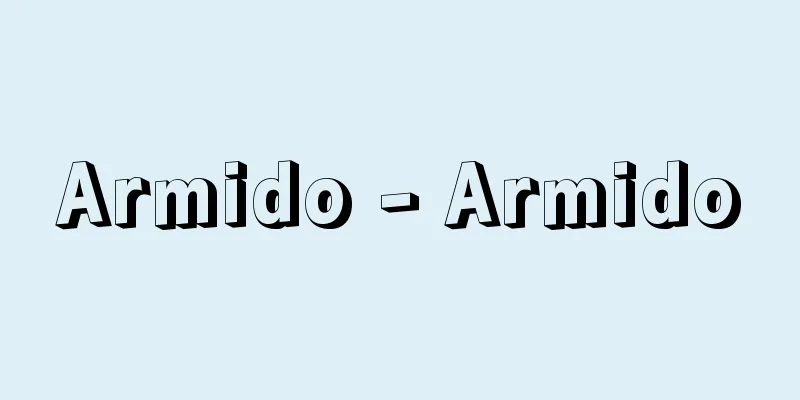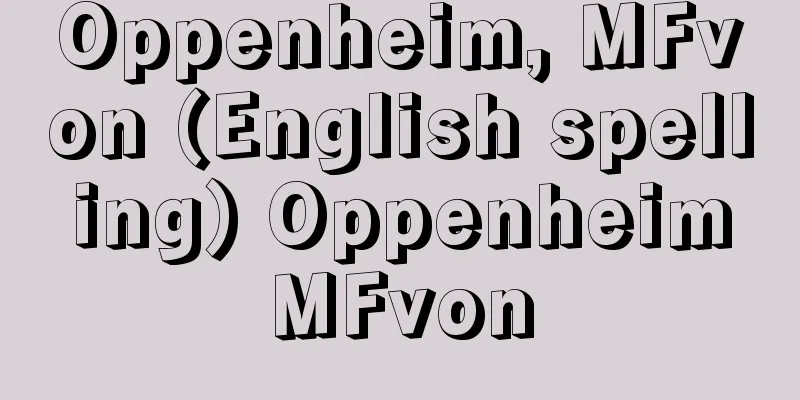Waltz - Waltz (English spelling)

|
A dance in three beats at moderate speed, and the dance itself. It can also be translated as "waltz". The dance is characterized by the fact that men and women embrace each other and dance in a circle, shifting their center of gravity in a wave-like pattern. [Ryuichi Tai] historyIts direct origin is in the dances generally known as German dances, such as the Ländler, a slow triple-beat dance that was danced in Bavaria, Germany, and Austria in the mid-18th century. The word waltz actually began to be used around 1780, and is said to have its origin in waltzen, which means "to turn or spin." After that, it quickly became popular as a new social dance, but was also suppressed for being immoral. However, after the Congress of Vienna held from 1814 to 1815, it spread throughout Europe and came to be danced by people of all classes. [Ryuichi Tai] Viennese WaltzThe Viennese waltz, established in the 1820s by Josef Lanner and Johann Strauss and his son, further promoted this waltz craze and took the world by storm. Its distinctive features are its unique rhythm, which slightly shifts the second and third beats, and its lengthy form, which combines several waltzes with an introduction and coda. With the advent of the Viennese waltz, the waltz became both entertaining and artistic. Other composers of the Viennese waltz include Zieler (Waldteufel, "The Skaters"), Ivanovic (Rapid Waves on the Danube), and Lehar (Gold and Silver). [Ryuichi Tai] Concert WaltzThe popularity of the waltz also inspired composers of art music, who began to create many concert waltzes. Early examples include Schubert's piano works and Weber's "Exhortation to the Dance." Later, many composers, including Chopin, Liszt, Saint-Saëns, Sibelius, and Glazunov, wrote various waltzes. Berlioz and Tchaikovsky also incorporated waltzes into their symphonies. In the 20th century, waltzes with a grotesque or nostalgic feel, such as those by Ravel and Satie, were born. [Ryuichi Tai] Waltz in Ballet and OperaWaltzes are also used in many ballets, operas, and operettas. Famous waltzes are found in ballets such as Delibes's Coppélia and Sylvia, and Tchaikovsky's three great ballets, and in operas such as Gounod's Faust and R. Strauss' Der Rosenkavalier. Many waltz-style songs have been created for operettas, such as Johann Strauss' Die Fledermaus. [Ryuichi Tai] Waltz VariationsWaltzes became popular worldwide, but at the same time, unique waltzes were born that combined with local music. For example, in Scandinavia, the waltz is called vallsi, but it has a slow tempo and is more similar to ländler. The valse musette, which is danced in the downtown area of Paris, is a waltz with an accent on the first beat, and is accompanied by a bagpipe musette (later replaced by the accordion). In North America, a slow waltz called Boston was loved, and became popular in Europe in the 1920s. It was also introduced to South America, and Colombia's pasillo and Peru's vals peruano are well known. The Peruvian version in particular has a mixed time signature of 3/4 and 6/8, and has a unique strength and flavor. [Ryuichi Tai] [References] | |Source: Shogakukan Encyclopedia Nipponica About Encyclopedia Nipponica Information | Legend |
|
中庸の速さの三拍子の舞曲、およびその舞踊。「円舞曲」とも訳される。舞踊の特色は、男女が抱き合うように組み、重心を波状に移動させながら円を描いて踊る点にある。 [田井竜一] 歴史その直接の起源は、18世紀の中ごろにドイツのバイエルン地方やオーストリアで踊られていた緩やかな三拍子のレントラーLändlerなど、一般にドイツ舞曲と総称される舞曲にある。実際ワルツということばが使われ始めたのは1780年ごろで、「回る・回転する」を意味するwaltzenがその語源であるといわれている。その後新しい社交ダンスとして急速に流行するようになったが、一方で不道徳であるという理由により弾圧を受けたりもした。しかし1814年から15年にかけて開催されたウィーン会議を契機にヨーロッパ全土に広まり、あらゆる階層の人々によって踊られるようになった。 [田井竜一] ウィンナ・ワルツこうしたワルツ熱をさらに助長し、一世を風靡(ふうび)したのが、ヨーゼフ・ランナーやヨハン・シュトラウス父子らによって1820年代以降に確立された「ウィンナ・ワルツ」である。その特色は、第二拍目と第三拍目をすこしずらす独特なリズムと、いくつかのワルツをつなぎあわせ、それに序奏とコーダをつけた長大な形式にある。ウィンナ・ワルツの登場によって、ワルツは娯楽性と芸術性を兼ね備えたものになったといえる。なおウィンナ・ワルツの作曲家にはこのほかツィーラー、『スケートをする人々』のワルトトイフェル、『ドナウ川のさざなみ』のイバノビッチ、『金と銀』のレハールなどがいる。 [田井竜一] 演奏会用ワルツまたワルツの流行は芸術音楽の作曲家にも刺激を与え、多数の演奏会用ワルツが生み出されるようになった。その初期の例として、シューベルトのピアノ作品やウェーバーの『舞踏への勧誘』をあげることができる。その後、ショパン、リスト、サン・サーンス、シベリウス、グラズーノフなどの多くの作曲家がさまざまなワルツを書いている。またベルリオーズやチャイコフスキーは、交響曲にワルツを導入した。20世紀になると、ラベルやサティの作品などグロテスクな感じや懐古趣味的な色彩を帯びたワルツも生まれるに至った。 [田井竜一] バレエ、オペラにおけるワルツさらにワルツはバレエやオペラおよびオペレッタにも数多く用いられている。バレエではドリーブの『コッペリア』『シルビア』、チャイコフスキーの三大バレエなど、オペラではグノーの『ファウスト』、R・シュトラウスの『ばらの騎士』などのワルツが有名である。オペレッタではヨハン・シュトラウスの『こうもり』にみられるように、ワルツ調の歌が数多くつくられた。 [田井竜一] ワルツのバリエーションワルツは世界的に流行したが、同時に各地にもともとあった音楽と融合した独特のワルツも誕生した。たとえば北欧のものはバルシュvallsiなどとよばれるが、テンポはゆっくりしており、むしろレントラーに近い性格をもつ。またパリの下町で踊られるバルス・ミュゼットvalse musetteは一拍目にアクセントがあるワルツで、バッグパイプのミュゼット(のちにアコーディオンにとってかわられた)の伴奏で踊られる。北アメリカではボストンBostonとよばれるゆったりとしたワルツが愛好され、1920年代にはヨーロッパでも流行した。さらに南アメリカにも導入され、コロンビアのパシージョpasillo、ペルーのバルス・ペルアーノvals peruanoなどがよく知られている。とくにペルーのものは、3/4拍子と6/8拍子の混合拍子で、独特の力強さと味わいをもっている。 [田井竜一] [参照項目] | |出典 小学館 日本大百科全書(ニッポニカ)日本大百科全書(ニッポニカ)について 情報 | 凡例 |
<<: Pierre Marie René Waldeck‐Rousseau
Recommend
Fairy tales - conte de fées (France)
In the narrow sense, it refers to supernatural sto...
Durum wheat
A type of wheat with 28 chromosomes, the same as e...
The Three Generations of Sanada
This is a storytelling that focuses on the rise an...
Oyasu [Hot Springs] - Good night
…A gorge in Minase Village, southeastern Akita Pr...
Mixteco (English spelling)
A Mexican Indian group. They live mainly in the st...
Taibo (English spelling)
The founder of the ancient Chinese marquis state o...
Union Alliance - Kumiai Doumei
Its official name was the Japan Labor Union Federa...
Frugality Order - Kenyaku Rei
During the Edo period, the shogunate and various ...
"Anjo Senwa" - Anjo Senwa
...It is a valuable record of a woman's warti...
Ekaku - Drawing
⇒ Hakuin Ekaku Source: Kodansha Digital Japanese N...
Christian temple - Christian temple
〘Noun〙 A Christian church. Nanbanji Temple . Sourc...
Dunlop Holdings PLC (Public Limited Company)
Dunlop is a holding company that owns the British ...
Johannes XII
937‐964 Pope of the Roman Empire. Reigned 955-964....
Araebisu
⇒ Nomura Kodo Source: Kodansha Digital Japanese Na...
Musa×paradisiaca
...A large perennial plant of the Musaceae family...





![Takasato [Village] - Takasato](/upload/images/67cc1cfc94c1e.webp)



